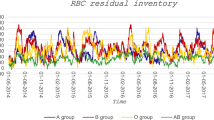Abstract
A safe and adequate blood supply is essential for healthcare systems to function effectively. Accurately forecasting blood demand plays a key role in efficient inventory management and resource allocation. Traditional forecasting methods, like moving averages and ARIMA models, often fall short due to the complexity of factors influencing blood demand. This study introduces an innovative hybrid ensemble model that combines Long Short-Term Memory (LSTM) networks with XGBoost, harnessing their combined strengths to enhance forecasting accuracy. By analyzing blood donation data from the Zakho Blood Bank (January 1, 2015—July 22, 2022), the model outperforms individual LSTM and XGBoost models, excelling in metrics such as Mean Square Error (MSE) and Mean Absolute Error (MAE). These findings underscore the potential of advanced machine learning techniques to improve healthcare supply chain management and ensure the timely availability of critical blood supplies.









Similar content being viewed by others
Data Availability
No datasets were generated or analysed during the current study.
References
Muhith A, Susanto IH, Rahmalia D, Adzkiya D, Herlambang T (2022) The analysis of demand and supply of blood in hospital in Surabaya City using panel data regression. Nonlinear Dyn Syst Theory 22(5):550–560
Thakur SK (2024) Forecasting demand for blood products: towards inventory management of a perishable product. Bioinformation 20(1):20–28. https://doi.org/10.6026/973206300200020
Mouncif C, Bellabdaoui A (2020) “Blood collection supply chain management: a critical review and future perspective”. 6th Int Conf Optim Appl ICOA 2020 - Proc. https://doi.org/10.1109/ICOA49421.2020.9094514
Ahamed T, Nazrul Islam M, Taslim Uddin Raju SM, Hashem MMA (2022) “Blood donor arrival forecasting using regression model and analysis of donor behavioural pattern”. In: Proc 2022 25th Int Conf Comput Inf Technol ICCIT 2022, pp 897–902. https://doi.org/10.1109/ICCIT57492.2022.10054710
Fortsch SM, Khapalova EA (2016) Reducing uncertainty in demand for blood. Oper Res Heal Care 9:16–28. https://doi.org/10.1016/j.orhc.2016.02.002
Nandi AK, Roberts DJ, Nandi AK (O. 2020) Improved long-term time-series predictions of total blood use data from England. Transfusion 60(10):2307–2318. https://doi.org/10.1111/trf.15966
Pushmika A, Naragala T, Abeygunawardhana PKW, Wijesekara Y, Muthukudaarachchi V, Liyanage R (2023) Predictive analytics for blood supply chain management and data security in healthcare system. ICAC 2023 - 5th Int. Conf. Adv. Comput. Technol. Innov. a Sustain. Econ. Proc., pp 292–297. https://doi.org/10.1109/ICAC60630.2023.10417194
Duan Y, Edwards JS, Dwivedi YK (2019) Artificial intelligence for decision making in the era of Big Data – evolution, challenges and research agenda. Int J Inf Manage 48:63–71. https://doi.org/10.1016/j.ijinfomgt.2019.01.021
Choi E, Schuetz A, Stewart WF, Sun J (2017) Using recurrent neural network models for early detection of heart failure onset. J Am Med Informatics Assoc 24(2):361–370. https://doi.org/10.1093/jamia/ocw112
Shickel B, Tighe PJ, Bihorac A, Rashidi P (2018) Deep EHR: a survey of recent advances in deep learning techniques for electronic health record (EHR) analysis. IEEE J Biomed Heal Informatics 22(5):1589–1604. https://doi.org/10.1109/JBHI.2017.2767063
Lipton ZC, Kale DC, Elkan C, Wetzel R (2016) Learning to diagnose with LSTM recurrent neural networks. 4th Int. Conf. Learn. Represent. ICLR 2016 - Conf. Track Proc., pp 1–18. https://doi.org/10.48550/arXiv.1511.03677
Hochreiter S, Schmidhuber J (1997) Long short-term memory. Neural Comput 9(8):1735–1780. https://doi.org/10.1162/neco.1997.9.8.1735
Li N, Chiang F, Down DG, Heddle NM (2021) “A decision integration strategy for short-term demand forecasting and ordering for red blood cell components”. Oper Res Heal Care vol 29. https://doi.org/10.1016/j.orhc.2021.100290
Siami-Namini S, Tavakoli N, Namin AS (2019) A comparative analysis of forecasting financial time series using ARIMA, LSTM, and BiLSTM. Available: http://arxiv.org/abs/1911.09512
Ramadhan M, Al-zebari A (2024) “Proposed a web-based intelligent system to manage the blood bank in Zakho District”. Qalaai Zanist Sci J 8(5):1247–1263. https://doi.org/10.25212/lfu.qzj.8.5.46
Ben Elmir W, Hemmak A, Senouci B (2023) Smart platform for data blood bank management: forecasting demand in blood supply chain using machine learning. Inf. 14(1):1–24. https://doi.org/10.3390/info14010031
Mohtashami A (2024) Design of blood supply chain optimization model using fuzzy approach and Markov chain under demand and supply uncertainty. 22(72).https://doi.org/10.22054/jims.2022.57027.2575
Khalilpourazari S, Hashemi Doulabi H (2023) A flexible robust model for blood supply chain network design problem. Ann Oper Res 328(1):701–726. https://doi.org/10.1007/s10479-022-04673-9
G SV, Ch R, D D (2024) “Remix-based real time blood bank communication integrating access control using XGBoost and Supabase”. In: 2024 IEEE Students Conference on Engineering and Systems (SCES), pp 1–6. https://doi.org/10.1109/SCES61914.2024.10652474
Ding X, Zhang X, Li X, Du J (2023) A hybrid neural network based model for blood donation forecasting. J Biomed Inform 146:104488. https://doi.org/10.1016/j.jbi.2023.104488
Funding
Not Applicable.
Author information
Authors and Affiliations
Contributions
Conceptualization, G.Z., R.Z., A.Z., and M.M.; methodology, G.Z., R.Z., and A.Z.; investigation, G.Z., R.Z., A.Z., and M.M.; resources, R.Z., A.Z., and M.M.; writing—original draft preparation, G.Z.; writing—review and editing, R.Z., A.Z., and M.M.; visualization, G.Z., R.Z., and A.Z.; supervision, G.Z.;
Corresponding author
Ethics declarations
Ethical Approval
Not Applicable.
Competing Interests
The authors declare no competing interests.
Rights and permissions
Springer Nature or its licensor (e.g. a society or other partner) holds exclusive rights to this article under a publishing agreement with the author(s) or other rightsholder(s); author self-archiving of the accepted manuscript version of this article is solely governed by the terms of such publishing agreement and applicable law.
About this article
Cite this article
Zebari, R.R., Zebari, G.M., Al-zebari, A. et al. LSTM-XGBoost: An Ensemble Model for Blood Demand Distribution Forecasting – A Case Study in Zakho City, Kurdistan Region, Iraq. Oper. Res. Forum 6, 14 (2025). https://doi.org/10.1007/s43069-024-00413-w
Received:
Accepted:
Published:
DOI: https://doi.org/10.1007/s43069-024-00413-w




